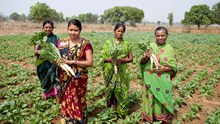
Food and Agriculture Organization (FAO) of the United Nations has upgraded its ABC-Map geospatial app, adding a powerful new indicator that reveals alarming projections for the future of global crop production. According to the latest data now available through the app, major crops like wheat, coffee, beans, cassava, and plantain may lose up to 50% of their optimal growing land by the end of the century due to worsening climate conditions.
The ABC-Map tool, short for Adaptation, Biodiversity and Carbon Mapping Tool, is a free, open-source application designed using Google Earth Engine. It helps policymakers, researchers, and project planners understand climate-related risks, biodiversity challenges, and carbon reduction potential in specific regions. With its latest update, the app now offers a new crop suitability indicator that projects how suitable land for cultivation will change under various future climate scenarios.
FAO's Senior Natural Resources Officer, Martial Bernoux, said the new feature is crucial in helping farmers and governments make informed decisions as climate change makes weather patterns more unpredictable. “Farmers, policymakers and technicians need to know if their chosen crops or agricultural projects will continue to work in the future or whether they need to adapt,” he said. “The updated ABC-Map can now support these decisions better and strengthen climate resilience.”
The updated data is based on a new study by French fintech company Finres, commissioned by the International Fund for Agricultural Development (IFAD) and funded by the French Development Agency (AFD). The research, titled Have crops already reached peak suitability, paints a worrying picture. It finds that five out of nine globally important food and cash crops are already losing their best-suited growing zones, and the decline is set to intensify.
According to the findings, five of the nine major staple and cash crops examined have already started losing their best cultivation zones, and this trend may intensify, particularly for coffee in traditional growing regions and wheat in North America and Europe. Meanwhile, crops like maize and rice may initially benefit from expanded suitable areas, but this advantage could disappear under high-emission scenarios by century’s end.
Launched in 2024, the ABC-Map app was introduced during the Global Forum for Food and Agriculture in Berlin as part of the COP28 Agriculture Toolkit. Users can now select from 30 crops and see how climate scenarios will impact their suitability in a given location up to the year 2100.
FAO also plans to add indicators on livestock heat stress and crop water requirements later this year. The tool aims to help governments and institutions prepare for the environmental shocks ahead while supporting global commitments under the Rio Conventions.















